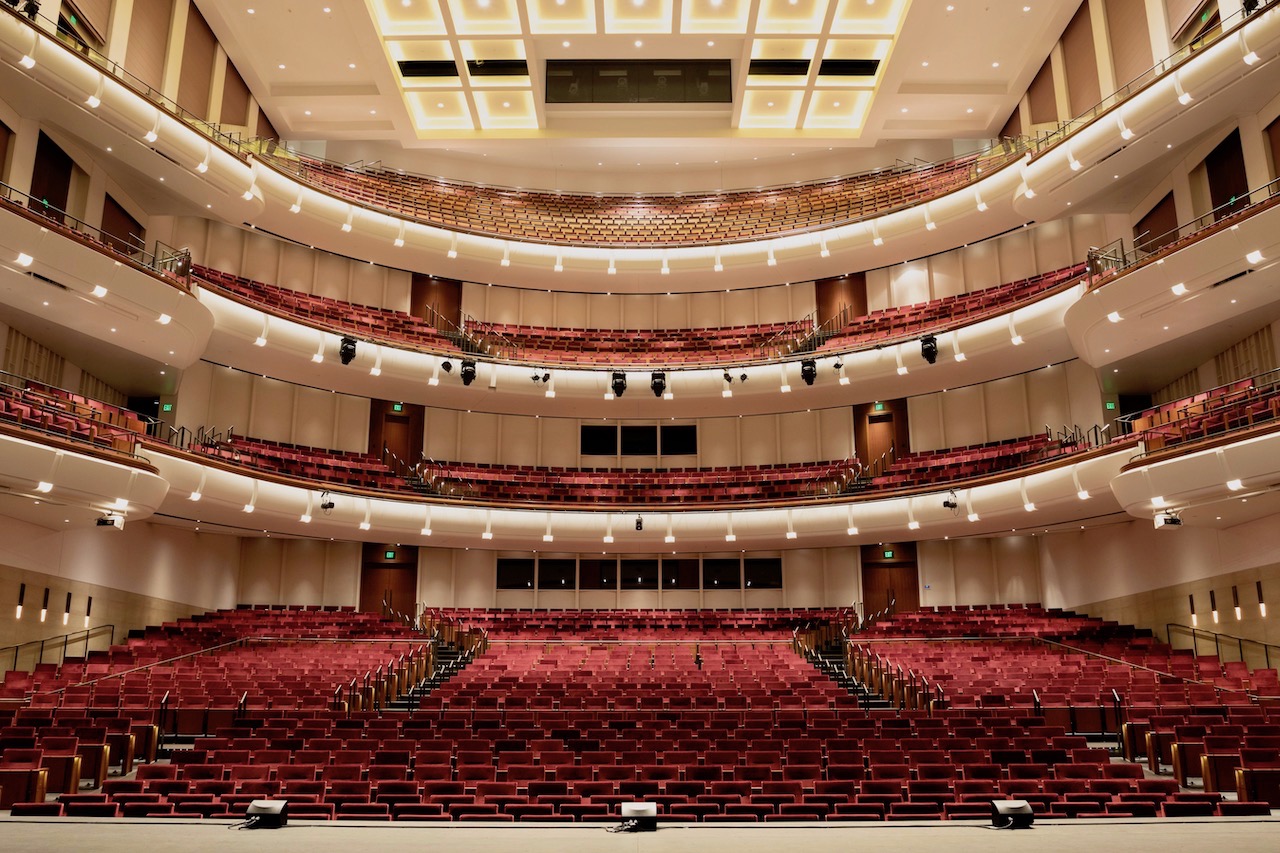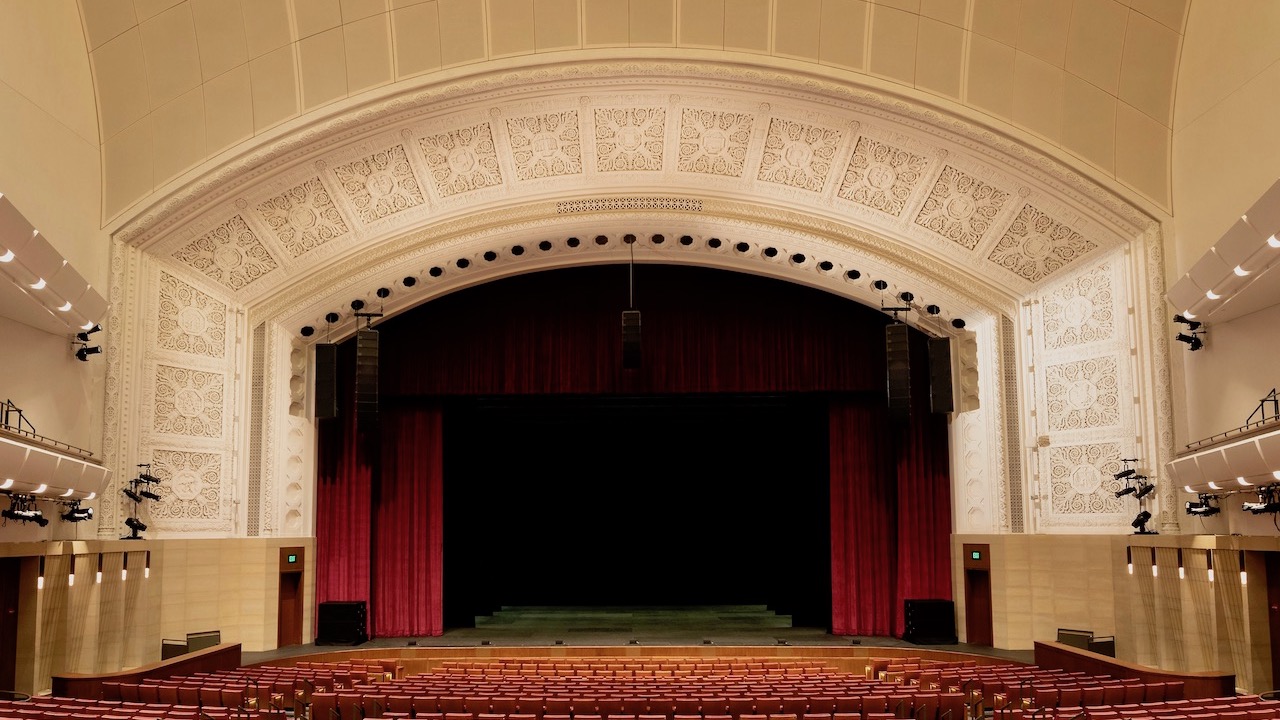In February 2020, Audio Logic Systems of Eden Prairie, MN completed the installation of d&b audiotechnik V and Y-Series loudspeaker systems in the Carlson Family Stage within Northrop Auditorium at the University of Minnesota. The new systems enable Northrop to achieve high-quality sound for its audiences and ensure the system complements the building’s refined aesthetics.
“As the modern use of the Carlson Family Stage has grown, the Northrop staff expressed the need for a system upgrade in the venue to meet touring riders of the A-list national and international performances targeted by the venues artistic planners,” said John Simshauser of Audio Logic Systems.
Related: d&b audiotechnik Debuts Flush-Mountable 44S Loudspeaker
The Carlson Family Stage is the venue’s main state-of-the-art theater that seats up to 2,700 with main floor seating of 1,100 and three additional wrap-around balconies. The Carlson Family Stage features excellent acoustics for concerts, dance performances, vocal events, and other performances while maintaining intimate sightlines for all seats.
Originally opened in 1929, Northrop Auditorium is a historic venue consisting of multiple performance and rehearsal spaces, a gallery, café and coffee shop, and offices for four university departments. The entire venue was completely renovated and reopened in 2014. Northrop has adapted this year to COVID-19 by offering online performances and limited-capacity live events that follow all University of Minnesota and Minnesota Department of Health safety guidelines.
Simshauser said that the Carlson Family Stage has amazing natural acoustics, and is a great place for amplified performances as well. “For amplified performances, however, it is a challenging space, not because of the acoustics but due to the physical variations of the room seating. The room is very intimate, minimizing the viewing distance for all seats by utilizing varied rake seating and varied balcony depths. Specifically, the upper balcony (The Gallery Circle) has a 34-foot longer acoustic throw then the lower balconies. Due to this room configuration, covering the room with a traditional line array deployment presented unique opportunities to implement advanced features of d&b loudspeaker systems like ArrayProcessing, which optimizes a line array’s tonal and level consistency over the entire coverage area. The three biggest challenges for sonic linearity throughout the seating area were the varying depths of the balconies, the limited trim height of the PA (impacting specifically the middle and upper balcony seating), and the extreme splay angles of the Y-Series center system required to cover the full height of the room.”
The sonic character of the large upper balcony significantly differs from the floor and lower balconies, specifically in the upper mid- and high frequency ranges. “For the V system, ArrayProcessing naturally addressed the challenges of the third balcony by taking into account the unique dimensions of that seating area,” Simshauser said. d&b ArrayProcessing settings for the V arrays shifted the level over distance +3dB from the non ArrayProcessing performance (or “intrinsic”) while using a Glory 5 processing emphasis. In relation to the upper balcony, the array (V-Series system) trim height is very low. The trim height of the arrays is less than half the height of the top row of seating (39 feet versus 89 feet). For the main V system to cover from the orchestra pit to the upper row the splay angles are greater than in many systems. ArrayProcessing addressed the low trim height challenge by calculating array frequency response over the entire range of seating distances.”

For the Y-Series array, the system specification called for a minimal number of boxes in the array due to sight line restrictions. There are 8 Y12s in the system. Four of the eight boxes are at a splay of 13 degrees, and six of the eight boxes have a splay of 9 degrees or greater. Simshauser said that “Without ArrayProcessing the level, variance at 4K between array elements from floor to balcony was +/- 18dB. ArrayProcessing effectively minimized the gaps in HF due to the extreme splay and the uniformity of HF coverage was greatly enhanced. To cover seating with such a large rake and throw distance variance, ideally twice as many Y12s would have been deployed in this situation. ArrayProcessing should never be a substitute for physical box count. However, in situations like this where box count is limited by external factors, ArrayProcessing is an extremely valuable tool to maximize performance and smooth array element interaction.”
The speaker arrays are configured as a left and right V array for music performance with a center Y array focused on speech. All arrays can be used as one system. Balancing the tonality of the system, both the V system for music and the Y system for speech reinforcement is especially challenging in the upper balcony. Array Processing looks at the entire system and maximizes interactions and effectively manages the overall tonal character of all elements.
The system also has significant subwoofer support. Eight flown V- SUBs and four SL-GSUBs support the main system. Simshauser added that “Due to the exceptional room acoustics, the distributed low-end reinforcement, and an all cardioid sub design, the low end is tight and impactful from the floor to the upper balcony. The final goal of any audio system upgrade is to make a significant positive impact in the daily experience of the audience, the performers, and the technicians.”
“The Northrop staff, d&b audiotechnik, and Audio Logic Systems have the utmost confidence that this system design and implementation will positively impact the Carlson Family Stage for years to come,” stated Justin T. Burke, Northrop’s technical director. “Our world-class venue deserved a world-class sound system.”
